Qatar Digital Transformation Market Size
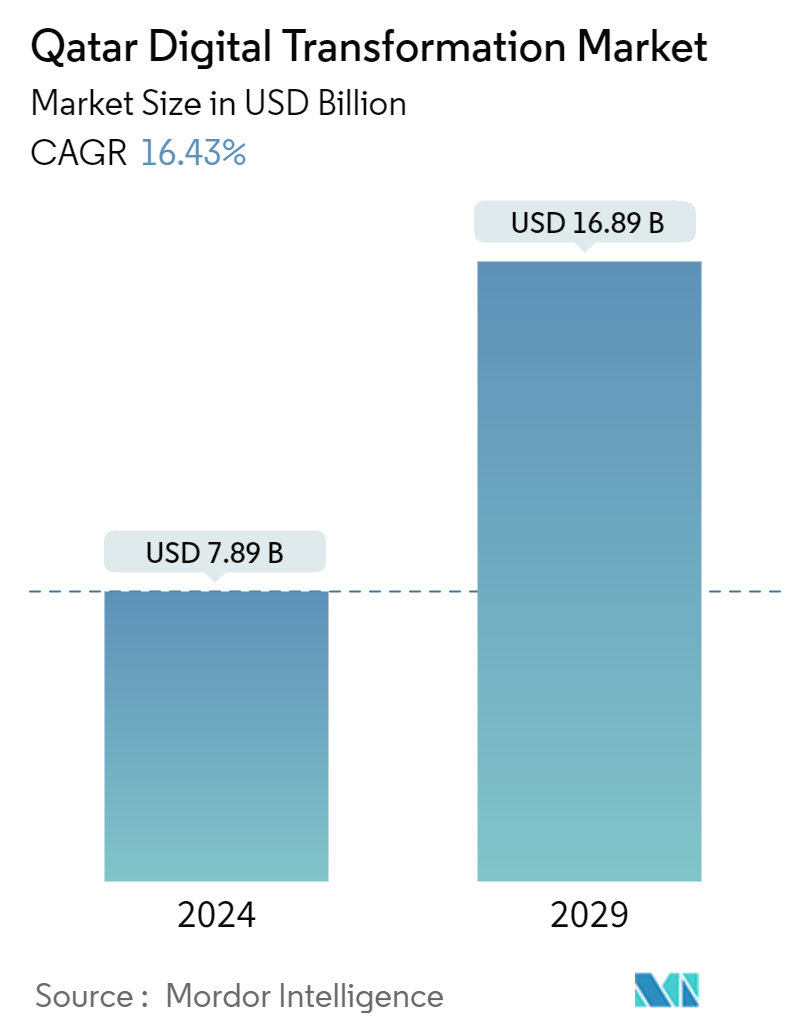
| Study Period | 2019 - 2029 |
| Base Year For Estimation | 2023 |
| Market Size (2024) | USD 7.89 Billion |
| Market Size (2029) | USD 16.89 Billion |
| CAGR (2024 - 2029) | 16.43 % |
| Market Concentration | Low |
Major Players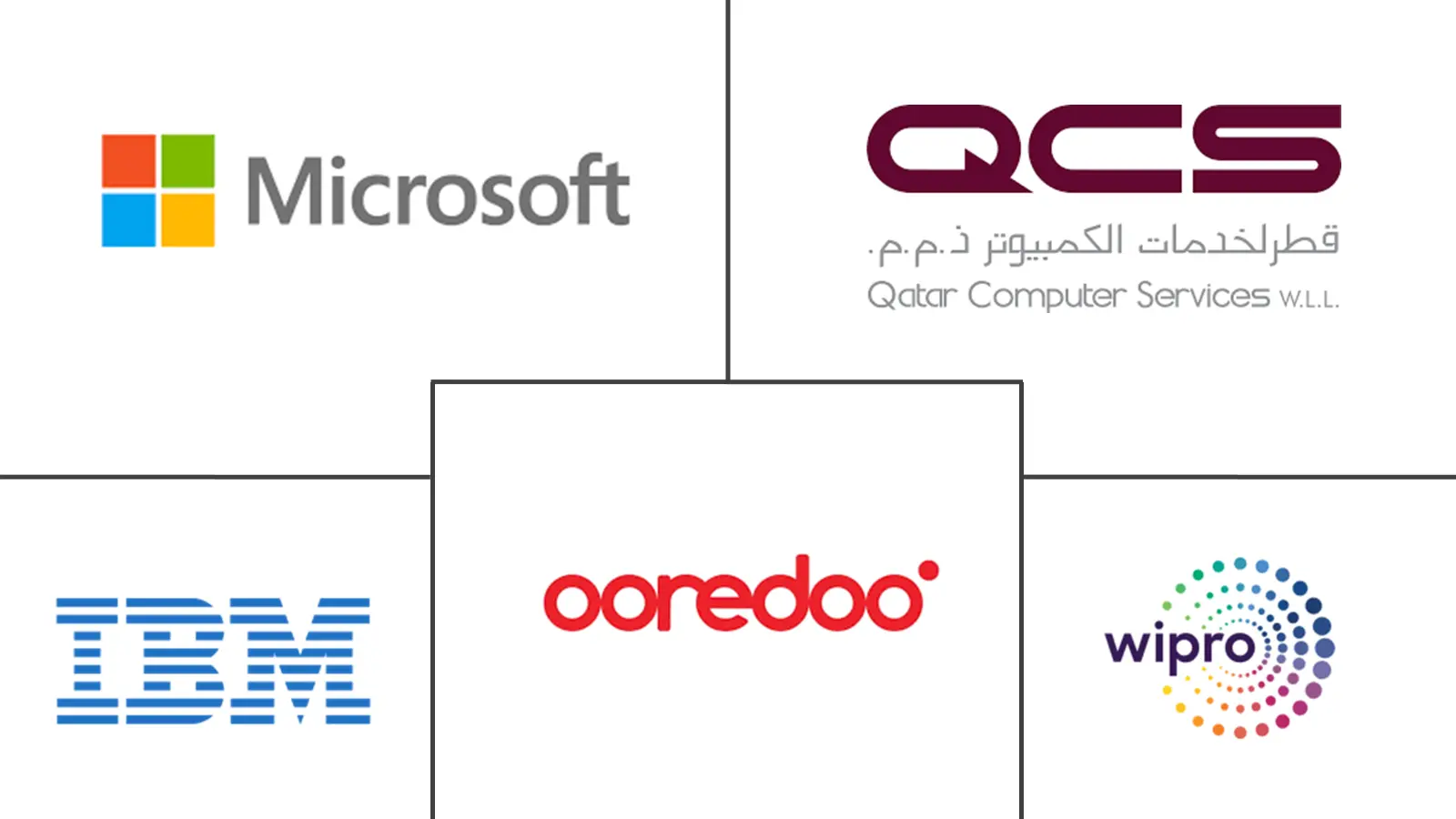
*Disclaimer: Major Players sorted in no particular order |
Qatar Digital Transformation Market Analysis
The Qatar Digital Transformation Market size is estimated at USD 7.89 billion in 2024, and is expected to reach USD 16.89 billion by 2029, growing at a CAGR of 16.43% during the forecast period (2024-2029).
- Qatar is experiencing significant growth in digital transformation, driven by a rising urban population and the increasing adoption of mobile phones that support 3G, 4G, and 5G services. Additionally, the market is benefiting from Qatar's smart city initiatives, which are further accelerating the country's digital transformation.
- In February 2024, the Investment Promotion Agency Qatar (Invest Qatar) and the Ministry of Communications and Information Technology (MCIT) released a report titled 'Smarter Qatar.' The report, 'Embracing Emerging Technologies and Innovation, Improving Lives, and Driving a Sustainable Digital Economy,' highlights Qatar's commitment to adopting advanced technologies to become a smart nation. It also details Qatar's strategic initiatives to leverage the global smart city market, which is projected to reach nearly USD 7 trillion by 2030.
- Qatar is rapidly advancing its internet connectivity, with a notable focus on enhancing both mobile and fixed broadband networks. As of April 2023, Speedtest reported that Qatar had the fastest average mobile internet connection globally, reaching nearly 190 Mbps. The United Arab Emirates (UAE) and Macau followed, each recording average median speeds above 170 Mbps.
- Further, major players in the country are investing in boosting the nations networking capabilities to improve its digital infrastructure. In November 2023, Nokia and Ooredoo Qatar achieved a notable feat by launching the Middle East and Africa's (MEA) inaugural private wireless network, tailored specifically for the energy sector. This initiative is designed to deliver exclusive voice and data services to even the most remote and demanding locales.
- In recent years, the Qatar National Vision 2030 and other governmental initiatives have prioritized expanding Qatar's financial services. The government is particularly interested in promoting partnerships between banks and the broader financial ecosystem to digitize and enhance services for citizens and businesses.
- However, Qatar's digital transformation is promising but faces challenges. A primary concern is security, particularly the fear of data being transferred outside the country. The increasing volume of data generated and stored digitally makes businesses vulnerable to data breaches.
Qatar Digital Transformation Market Trends
Analytics, Artificial Intelligence and Machine Learning is expected to boost the Market Growth
- By leveraging technologies such as artificial intelligence, machine learning, and others, Qatar has driven economic growth and improved its quality of life through the development of digital infrastructure and the creation of enabling ecosystems.
- In 2023, Qatar advanced to the 48th position in the Digital Quality of Life Index, achieving a value of 0.53, up from 0.51 the previous year. This index evaluates five key pillars: internet affordability, internet quality, e-infrastructure, e-security, and e-government, using 14 indicators. Scores range from zero to one, with one representing the highest quality of digital well-being.
- The government is actively involved in accelerating the country's digital growth and has invested significantly to support it. In March 2024, Qatar earmarked a substantial QAR 9 billion (USD 2.47 billion) incentive package for artificial intelligence (AI) initiatives, signaling a strategic shift towards a holistic digital transformation.
- Google Cloud’s introduction in Qatar opens doors for enterprises and startups to harness advanced technologies, with a special emphasis on artificial intelligence (AI). In February 2024, Ooredoo, a telecom company based in Qatar, collaborated with Google Cloud. This partnership is poised to transform Ooredoo Qatar's data analytics and Artificial Intelligence (AI) capabilities. Leveraging Google Cloud's machine learning and AI solutions, alongside its Smart Analytics tools, Ooredoo Qatar aims to delve deeper into customer preferences and needs. These insights enhance network performance and refine personalized offerings and bolster proactive customer support.
- Moreover, in May 2024, the Qatar Free Zones Authority (QFZ) and Quantiphi, a Google Cloud partner, have signed an agreement to establish a global technology hub in Qatar’s Free Zones. This initiative aims to meet the growing demand for AI and generative AI enterprise solutions, driving innovation and accelerating digital transformation initiatives across Qatar and the region.
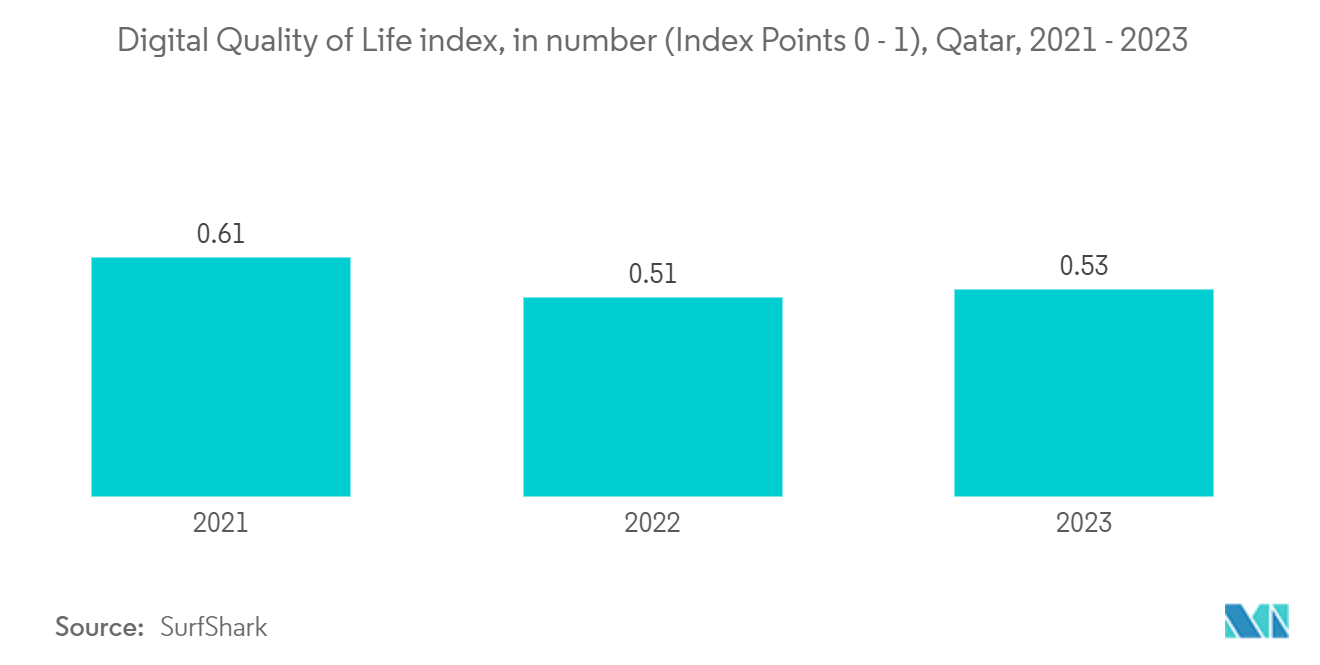
Oil, Gas and Energy to Have a Major Share in the Market
- The energy sector is going through a profound transformation driven by digital technologies. The shift spans from embracing renewable energy sources to implementing smart grids, fundamentally altering the production, distribution, and consumption dynamics of energy. Moreover, it can help cut costs, boost output, and reduce carbon emissions in the oil and gas sector
- Qatar's natural gas production, as reported by the Energy Institute, reached approximately 181 billion cubic meters in 2023, up from 177 billion cubic meters in 2021. As gas production expands, managing operations becomes increasingly challenging. Utilizing digital technologies such as AI and IoT is essential to optimize production, reduce costs, and enhance efficiency.
- In February 2024, Petrotec collaborated with Siemens to advance Qatar’s digital energy transformation. This partnership will enhance operational efficiency, optimize asset performance, reduce downtime, implement eco-friendly solutions, and improve resource management.
- The global shift towards sustainability and the move to renewable energy sources have made it imperative to embrace digital technologies for more effective energy generation, storage, and distribution. According to the International Renewable Energy Agency (IRENA), Qatar's installed renewable energy capacity surged to approximately 824 megawatts by 2022, a significant rise from the 24 megawatts recorded the year prior.
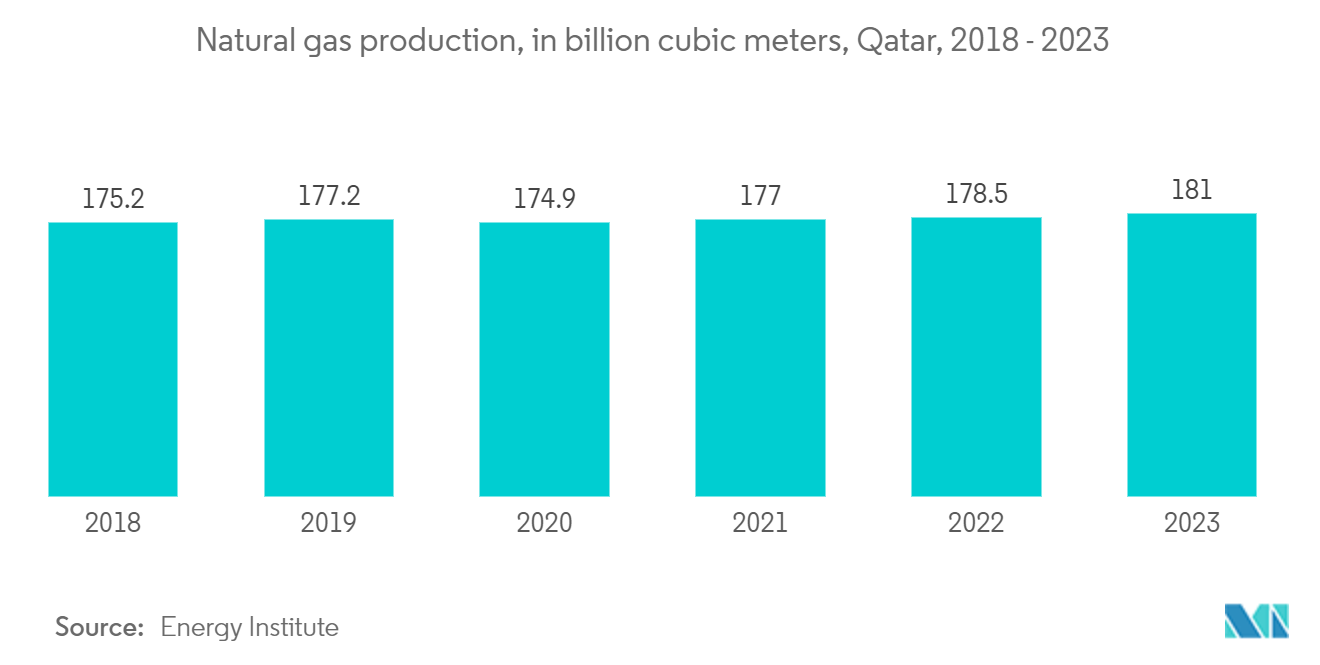
Qatar Digital Transformation Industry Overview
The Qatar Digital Transformation Market is fragmented, with numerous players currently operating. Key players in the ICT market are continuously striving for advancements. Several prominent companies are forming collaborations and expanding their presence in developing regions to strengthen their market positions. Oracle Corporation, International Business Machines Corp. (IBM), Wipro Doha LLC, and Ooredoo Qatar, among others, are major players.
- July 2024: MEEZA, a leading provider of managed IT services and data centers in Qatar, announced a strategic partnership with AMD, a prominent player in high-performance computing and graphics solutions. Through this collaboration, MEEZA aims to leverage AMD's advanced computing platform to drive the AI revolution in Qatar and beyond.
- May 2024: DDN, a global provider of artificial intelligence (AI) and multi-cloud data management solutions, partnered with Ooredoo, Qatar's telecommunications operator and ICT provider. Through this alliance, DDN's advanced AI capabilities position Ooredoo at the forefront of the ICT landscape, bolstering its service portfolio. Ooredoo will adopt DDN’s sophisticated AI infrastructure, including sovereign AI capabilities, to drive innovation and improve operational efficiencies across its networks.
Qatar Digital Transformation Market Leaders
-
IBM Corporation
-
Microsoft Corporation
-
Ooredoo Qatar
-
Wipro Limited
-
Qatar Computer Services
*Disclaimer: Major Players sorted in no particular order
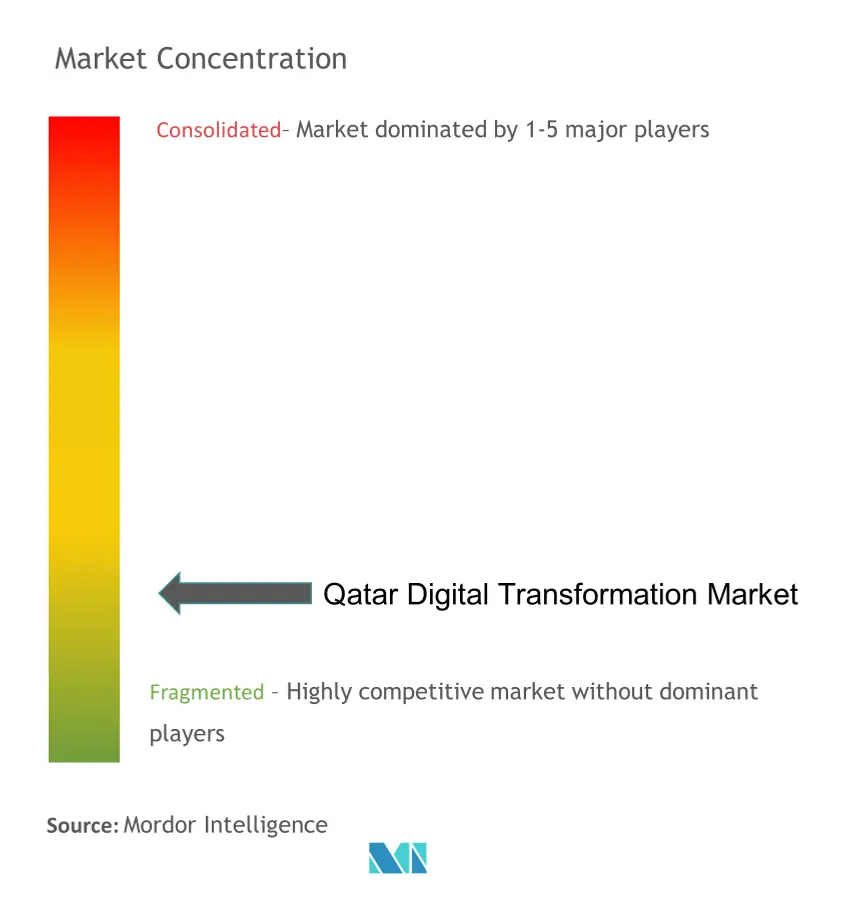
Qatar Digital Transformation Market News
- June 2024: Ooredoo, Qatar’s leading telecommunications operator and ICT provider, launched "Clean Energy – Super Hybrid" program. This initiative aims to transform energy consumption at mobile outdoor sites by utilizing a mix of eco-friendly energy sources, such as solar and wind power.
- May 2024: Orbus Software launched a new node in Qatar for its SaaS platform, OrbusInfinity. This platform accelerates business transformation through enterprise architecture management. The new node allows users in Qatar to connect to the Azure Data Centre in Doha, ensuring compliance with data sovereignty and residency requirements for government organizations and highly regulated sectors such as banking and healthcare.
Qatar Digital Transformation Market Report - Table of Contents
1. INTRODUCTION
- 1.1 Study Assumptions and Market Definition
- 1.2 Scope of the Study
2. RESEARCH METHODOLOGY
3. EXECUTIVE SUMMARY
4. INDUSTRY ECOSYSTEM ANALYSIS (Detailed Coverage of Key Stakeholders in Digital Transformation Industry Product/Solution Providers, System Integrators/VARs, Connectivity Providers, Regulatory Bodies, End-users, Service Providers, etc.)
5. MARKET DYNAMICS
-
5.1 Market Drivers
- 5.1.1 Increase in the adoption of big data analytics and other technologies in the country
- 5.1.2 The rapid proliferation of mobile devices and apps
-
5.2 Market Restraints
- 5.2.1 Concerns about the Privacy and Security of Information
6. CURRENT MARKET SCENARIO AND EVOLUTION OF DIGITAL TRANSFORMATION PRACTICES
7. KEY METRICS
- 7.1 Technology Spending Trends
- 7.2 Number of IoT Devices
- 7.3 Total Cyberattacks
- 7.4 Technology Staffing Trends
- 7.5 Internet growth and penetration in the country
- 7.6 Digital Competitiveness Ranking
- 7.7 fixed and mobile broadband coverage
- 7.8 Cloud adoption
- 7.9 AI adoption
- 7.10 E-commerce penetration
8. MARKET SEGMENTATION
-
8.1 By Type
- 8.1.1 Analytics, Artificial Intelligence and Machine Learning
- 8.1.1.1 Current Market Scenario and Market Projections for the Forecast Period
- 8.1.1.2 Key Growth Influencers (Drivers, Challenges, and Opportunities)
- 8.1.1.3 Use Case Analysis
- 8.1.1.4 Market Outlook
- 8.1.2 Extended Reality (XR)
- 8.1.2.1 Current Market Scenario and Market Projections for the Forecast Period
- 8.1.2.2 Key Growth Influencers (Drivers, Challenges, and Opportunities)
- 8.1.2.3 Use Case Analysis
- 8.1.2.4 Market Outlook
- 8.1.3 IoT
- 8.1.3.1 Current Market Scenario and Market Projections for the Forecast Period
- 8.1.3.2 Key Growth Influencers (Drivers, Challenges, and Opportunities)
- 8.1.3.3 Use Case Analysis
- 8.1.3.4 Market Outlook
- 8.1.4 Industrial Robotics
- 8.1.4.1 Current Market Scenario and Market Projections for the Forecast Period
- 8.1.4.2 Key Growth Influencers (Drivers, Challenges, and Opportunities)
- 8.1.4.3 Use Case Analysis
- 8.1.4.4 Market Outlook
- 8.1.5 Blockchain
- 8.1.5.1 Current Market Scenario and Market Projections for the Forecast Period
- 8.1.5.2 Key Growth Influencers (Drivers, Challenges, and Opportunities)
- 8.1.5.3 Market Outlook
- 8.1.6 Additive Manufacturing/3D Printing
- 8.1.6.1 Current Market Scenario and Market Projections for the Forecast Period
- 8.1.6.2 Key Growth Influencers (Drivers, Challenges, and Opportunities)
- 8.1.6.3 Use Case Analysis
- 8.1.6.4 Market Outlook
- 8.1.7 Cybersecurity
- 8.1.7.1 Current Market Scenario and Market Projections for the Forecast Period
- 8.1.7.2 Key Growth Influencers (Drivers, Challenges, and Opportunities)
- 8.1.7.3 Use Case Analysis
- 8.1.7.4 Market Outlook
- 8.1.8 Cloud Edge Computing
- 8.1.8.1 Current Market Scenario and Market Projections for the Forecast Period
- 8.1.8.2 Key Growth Influencers (Drivers, Challenges, and Opportunities)
- 8.1.8.3 Use Case Analysis
- 8.1.8.4 Market Outlook
- 8.1.9 Others (digital twin, mobility and connectivity)
- 8.1.9.1 Current Market Scenario and Market Projections for the Forecast Period
- 8.1.9.2 Key Growth Influencers (Drivers, Challenges, and Opportunities)
- 8.1.9.3 Market Breakdown by Type (Digital Twin, Mobility and Connectivity)
- 8.1.9.4 Use Case Analysis
- 8.1.9.5 Market Outlook
-
8.2 By End-User Industry
- 8.2.1 Manufacturing
- 8.2.2 Oil, Gas and Utilities
- 8.2.3 Retail & e-commerce
- 8.2.4 Transportation and Logistics
- 8.2.5 Healthcare
- 8.2.6 BFSI
- 8.2.7 Telecom and IT
- 8.2.8 Government and Public Sector
- 8.2.9 Others (Education, Media & Entertainment, Environment etc)
9. COMPETITIVE LANDSCAPE
-
9.1 Company Profiles*
- 9.1.1 IBM Corporation
- 9.1.2 Microsoft Corporation
- 9.1.3 Ooredoo Qatar
- 9.1.4 Wipro Limited
- 9.1.5 Qatar Computer Services
- 9.1.6 Oracle Corporation
- 9.1.7 Dell Technologies
- 9.1.8 Tech Mahindra
- 9.1.9 AAJ Technologies
- 9.1.10 Cisco Systems, Inc.
- 9.1.11 Vistas Global
10. KEY TRANSFORMATIVE TECHNOLOGIES
- 10.1 Quantum Computing
- 10.2 Manufacturing as a Service (MaaS)
- 10.3 Cognitive Process Automation
- 10.4 Nanotechnology
Qatar Digital Transformation Industry Segmentation
Digital transformation leverages digital technologies such as artificial intelligence and machine learning, extended reality (XR) for industrial applications, and IoT to create new business processes or modify existing ones, reshape organizational culture, and enhance customer experiences.
Qatari digital transformation market is segmented by type (analytics, artificial intelligence, and machine learning, extended reality (XR), IoT, industrial robotics, blockchain, additive manufacturing/3D printing, cybersecurity, cloud, and edge computing, and others (digital twin, mobility, and connectivity)) end-user industry (manufacturing, oil, gas and utilities, retail & e-commerce, transportation and logistics, healthcare, BFSI, telecom and IT, government and public sector, and others (education, media & entertainment, environment etc)). The market sizes and forecasts are provided in terms of value in USD for all the above segments.
| By Type | Analytics, Artificial Intelligence and Machine Learning | Current Market Scenario and Market Projections for the Forecast Period |
| Key Growth Influencers (Drivers, Challenges, and Opportunities) | ||
| Use Case Analysis | ||
| Market Outlook | ||
| By Type | Extended Reality (XR) | Current Market Scenario and Market Projections for the Forecast Period |
| Key Growth Influencers (Drivers, Challenges, and Opportunities) | ||
| Use Case Analysis | ||
| Market Outlook | ||
| By Type | IoT | Current Market Scenario and Market Projections for the Forecast Period |
| Key Growth Influencers (Drivers, Challenges, and Opportunities) | ||
| Use Case Analysis | ||
| Market Outlook | ||
| By Type | Industrial Robotics | Current Market Scenario and Market Projections for the Forecast Period |
| Key Growth Influencers (Drivers, Challenges, and Opportunities) | ||
| Use Case Analysis | ||
| Market Outlook | ||
| By Type | Blockchain | Current Market Scenario and Market Projections for the Forecast Period |
| Key Growth Influencers (Drivers, Challenges, and Opportunities) | ||
| Market Outlook | ||
| By Type | Additive Manufacturing/3D Printing | Current Market Scenario and Market Projections for the Forecast Period |
| Key Growth Influencers (Drivers, Challenges, and Opportunities) | ||
| Use Case Analysis | ||
| Market Outlook | ||
| By Type | Cybersecurity | Current Market Scenario and Market Projections for the Forecast Period |
| Key Growth Influencers (Drivers, Challenges, and Opportunities) | ||
| Use Case Analysis | ||
| Market Outlook | ||
| By Type | Cloud Edge Computing | Current Market Scenario and Market Projections for the Forecast Period |
| Key Growth Influencers (Drivers, Challenges, and Opportunities) | ||
| Use Case Analysis | ||
| Market Outlook | ||
| By Type | Others (digital twin, mobility and connectivity) | Current Market Scenario and Market Projections for the Forecast Period |
| Key Growth Influencers (Drivers, Challenges, and Opportunities) | ||
| Market Breakdown by Type (Digital Twin, Mobility and Connectivity) | ||
| Use Case Analysis | ||
| Market Outlook | ||
| By End-User Industry | Manufacturing | |
| Oil, Gas and Utilities | ||
| Retail & e-commerce | ||
| Transportation and Logistics | ||
| Healthcare | ||
| BFSI | ||
| Telecom and IT | ||
| Government and Public Sector | ||
| Others (Education, Media & Entertainment, Environment etc) |
Qatar Digital Transformation Market Research FAQs
How big is the Qatar Digital Transformation Market?
The Qatar Digital Transformation Market size is expected to reach USD 7.89 billion in 2024 and grow at a CAGR of 16.43% to reach USD 16.89 billion by 2029.
What is the current Qatar Digital Transformation Market size?
In 2024, the Qatar Digital Transformation Market size is expected to reach USD 7.89 billion.
Who are the key players in Qatar Digital Transformation Market?
IBM Corporation, Microsoft Corporation, Ooredoo Qatar, Wipro Limited and Qatar Computer Services are the major companies operating in the Qatar Digital Transformation Market.
What years does this Qatar Digital Transformation Market cover, and what was the market size in 2023?
In 2023, the Qatar Digital Transformation Market size was estimated at USD 6.59 billion. The report covers the Qatar Digital Transformation Market historical market size for years: 2019, 2020, 2021, 2022 and 2023. The report also forecasts the Qatar Digital Transformation Market size for years: 2024, 2025, 2026, 2027, 2028 and 2029.
Qatar Digital Transformation Industry Report
Statistics for the 2024 Qatar Digital Transformation market share, size and revenue growth rate, created by Mordor Intelligence™ Industry Reports. Qatar Digital Transformation analysis includes a market forecast outlook for 2024 to 2029 and historical overview. Get a sample of this industry analysis as a free report PDF download.



